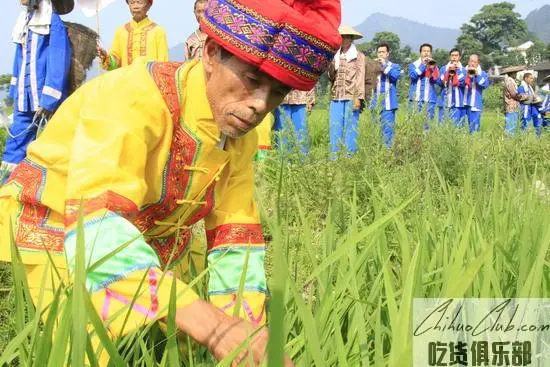
Xinhuang Red Rice
-
Update date::
-
Date of protection::
-
Protected range:The production area of Xinhuangyu Tibetan Red Rice is the administrative area under the jurisdiction of Xinhuang Dong Autonomous County of Hunan Province.
-
Related origin:
-
Category:
In addition to rich trace elements such as selenium, iron, zinc, calcium and magnesium, as well as plant proteins and vegetable fats, the red rice is also rich in B1, B2, B6 and other vitamins and 18 essential amino acids. The comprehensive nutritional value is far better than the Thai fragrant rice.
Hunan Xinhuangyu Tibetan Red Rice Planting System is located in Xinhuang Dong Autonomous County, Huaihua City, Hunan Province, China. It is the historical heritage of farming civilization in Xinhuang Township for thousands of years. Red rice is a precious and rare species resource. For thousands of years, the Tibetan red rice has been preserved in Xinhuangyu Township, Huaihua, Hunan Province, the birthplace of hybrid rice, with its unique human geography and cultivation practices. The red rice is not only the food of the family, but also the spiritual pillar of the family's advocating nature. It is regarded as a god by the family, and has a folk culture such as witchcraft culture, sacrifice culture, birth culture, song and dance culture, festival culture, etc. close relationship. On the mountain, the mountains are closed for afforestation, and the water is irrigated under the mountain. The forest and rice are mutually complementary. The circulatory system of water and drought rotation not only enriches the planting structure of crops, but also improves the nutrient composition of the soil. The organic combination of the planting system and the fish farming duck system has invisibly established a virtuous cycle of agro-ecological system. The Xinhuangzang Tibetan Red Rice Planting System has a history of 8,000 years. Today, with the increasing influence of modern agricultural technology, the preservation of abundant rice resources not only has a positive effect on enriching China's rice genetic resources, rice production, variety improvement, rice research and ecological security, but also solving the future of mankind. Material security for food security. In addition to rich trace elements such as selenium, iron, zinc, calcium and magnesium, as well as plant proteins and vegetable fats, the red rice is also rich in B1, B2, B6 and other vitamins and 18 essential amino acids. The comprehensive nutritional value is far better than the Thai fragrant rice. At present, due to lack of understanding, lack of policies, sharp decline in rural labor, coupled with the impact of urbanization and industrialization and the comprehensive promotion of high-quality hybrid rice, the use of modern agricultural technologies such as fertilizers and pesticides, etc., the red rice planting system The inheritance and development of the company face great challenges. In recent years, the government has focused on protecting the red rice planting system through measures such as the establishment of core protected areas, and strives to make the farmers in the protected areas fully benefit, while the red rice cultivation and red rice culture are further inherited and protected. And development and utilization.
Technical requirements for the quality of Xinhuang sorghum red rice 1. Variety Local traditional red rice varieties. Second, the site conditions The slate, shale-based soil parent material, soil type is red soil, yellow soil and paddy soil. The thickness of rice tillage layer is ≥25cm, the pH value is 5.0 to 7.0, and the organic matter content is ≥3.0%. The river water and mountain spring water are the main irrigation. The altitude is between 350 and 700 meters. Third, cultivation management 1. Promote germination. Soaking seeds and germination in mid-April, soaking seeds at 15 to 17 °C for 3 to 4 days, and germination for 1 to 2 days at 30 to 32 °C. 2. Nursery. The sowing time is from April 15 to 25. The amount of seedlings for wet breeding in Daejeon is 2kg/667m2 (mu), and that in dry land is 1.5kg/667m2 (mu). 3. Insert. The transplanting time is from May 15 to 25, the middle nursery age is 30 to 35 days, and the large seedling age is 35 to 40 days. The transplanting density is ≥1.6 million 蔸/667m2 (mu), 3 to 4 plants per raft. 4. Field fertilizer management. Each 667m2 (mu) organic fertilizer ≥1000kg, nitrogen-phosphorus-potassium compound compound fertilizer ≤30kg, urea ≤5kg, potassium chloride ≤10kg. 5. Prevention, environmental and safety requirements. Ecological control techniques such as agricultural rotation, rice field fish farming (duck) and physical control technology for solar insect killing lamps are adopted. The use of chemical fertilizers and pesticides must comply with relevant national regulations. 4. Harvesting The harvest period is from September 25 to October 10, irrigation is stopped 30 days before harvesting, and drainage begins 10 days before harvesting. V. Processing of rice → initial cleaning → cleaning → stone removal → glutinous rice → grain separation → whole grading → soft polishing → color selection → length selection grading → packaging six, quality characteristics 1. Sensory indicators: rice grains are reddish brown, Slim; tastes astringent, with a strong bean flavor. 2. Physical and chemical indicators: Name index protein g/100g 6.0-10.0 Gel consistency mm 80.0-96.0 Amylose (dry basis)% 5.0-10.0 Selenium mg/kg 0.03-0.3 3. Safety and other quality technical requirements: product safety and Other quality technical requirements must comply with relevant national regulations.
Apply to:
Producers within the scope of the production of new sorghum saffron rice may apply to the Food and Drug Industry and Commerce Quality Supervision Administration of Xinhuang Dong Autonomous County for the use of the \"Special Mark for Geographical Indication Products\", which is reviewed by the Quality and Technical Supervision Bureau of Hunan Province and reported to the quality inspection. Announcement after approval by the General Administration. The inspection mechanism of Xinhuangxu Tibetan Red Rice is selected by the Hunan Provincial Bureau of Quality and Technical Supervision in the inspection institutions that meet the qualification requirements.